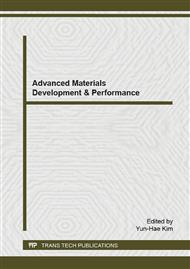[1]
C. Gomez-Navarro, R. T. Weitz, A. M. Bittner, M. Scolari, A. Mews, M. Burghard, K. Kern, Electronic transport properties of individual chemically reduced graphene oxide sheets, Nano Lett. 7 (2007) 3499-3503.
DOI: 10.1021/nl072090c
Google Scholar
[2]
M. I. Katsnelson, K. S. Novoselov, Graphene: New bridge between condensed matter physics and quantum electrodynamics, Solid State Commun. 143 (2007) 3-13.
DOI: 10.1016/j.ssc.2007.02.043
Google Scholar
[3]
J. C. Meyer, A. K. Geim, M. I. Katsnelson, K. S. Novoselov, T. J. Booth, S. Roth, The structure of suspended graphene sheets, Nature 446 (2007) 60-63.
DOI: 10.1038/nature05545
Google Scholar
[4]
N. G. Shang, P. Papakonstantinou, M. McMullan, M. Chu, A. Stamboulis, A. Potenza, S. S. Dhesi, H. Marchetto, Catalyst-Free Efficient Growth, Orientation and Biosensing Properties of Multilayer Graphene Nanoflake Films with Sharp Edge Planes, Adv. Funct. Mater. 18 (2008).
DOI: 10.1002/adfm.200800951
Google Scholar
[5]
H. A. Weng, C. C. Wu, C. C. Chen, C. C. Ho, S. J. Ding, Preparation and properties of gold nanoparticle-electrodeposited titanium substrates with Arg-Gly-Asp-Cys peptides, J. Mater. Sci. Mater. Med. 21 (2010) 1511-1519.
DOI: 10.1007/s10856-010-4026-4
Google Scholar
[6]
N. Li, X. Zhang, Q. Song, R. Su, Q. Zhang, T. Kong, L. Liu, G. Jin, M. Tang, G. Cheng, The promotion of neurite sprouting and outgrowth of mouse hippocampal cells in culture by graphene substrates, Biomater. 32 (2011) 9374-9382.
DOI: 10.1016/j.biomaterials.2011.08.065
Google Scholar
[7]
O. Vittorio, V. Raffa, A. Cuschieri, Influence of purity and surface oxidation on cytotoxicity of multiwalled carbon nanotubes with human neuroblastoma cells, Nanomedicine. 5 (2009) 424-431.
DOI: 10.1016/j.nano.2009.02.006
Google Scholar
[8]
M. Lv, Y. Zhang, L. Liang, M. Wei, W. Hu, X. Li, Q. Huang, Effect of graphene oxide on undifferentiated and retinoic acid-differentiated SH-SY5Y cells line, Nanoscale. 4 (2012) 3861-3866.
DOI: 10.1039/c2nr30407d
Google Scholar
[9]
Z. Xun, D. Y. Lee, J. Lim, C. A. Canaria, A. Barnebey, S. M. Yanonne, C. T. McMurray, Retinoic acid-induced differentiation increases the rate of oxygen consumption and enhances the spare respiratory capacity of mitochondria in SH-SY5Y cells, Mech. Age. Dev. 133 (2012).
DOI: 10.1016/j.mad.2012.01.008
Google Scholar
[10]
S. Y. Park, J. Park, S. H. Sim, M. G. Sung, K. S. Kim, B. H. Hong, S. Hong, Enhanced differentiation of human neural stem cells into neurons on graphene, Adv. Mater. 23 (2011) H263-267.
DOI: 10.1002/adma.201101503
Google Scholar
[11]
T. R. Nayak, , H. Andersen, V. S. Makam, C. Khaw, S. Bae, X. Xu, P. L. Ee, J. H. Ahn, B. H. Hong, G. Pastorin, B. Ozyilmaz, Graphene for controlled and accelerated osteogenic differentiation of human mesenchymal stem cells, ACS nano. 5 (2011).
DOI: 10.1021/nn200500h
Google Scholar
[12]
S. B. Jo, J. Park, W. H. Lee, K. Cho, B. H. Hong, Large-area graphene synthesis and its application to interface-engineered field effect transistors, Solid State Commun. 152 (2012) 1350-1358.
DOI: 10.1016/j.ssc.2012.04.056
Google Scholar
[13]
S. Bae, H. Kim, Y. Lee, X. F. Xu, J. S. Park, Y. Zheng, J. Balakrishnan, T. Lei, H. R. Kim, Y. I. Song, Y. J. Kim, K. S. Kim, B. Ozyilmaz, J. H. Ahn, B. H. Hong, S. Iijima, Roll-to-roll production of 30-inch graphene films for transparent electrodes, Nat. Nanotechnol. 5 (2010).
DOI: 10.1038/nnano.2010.132
Google Scholar
[14]
Y. Chang, S. T. Yang, J. H. Liu, E. Dong, Y. Wang, A. Cao, Y. Liu, H. Wang, In vitro toxicity evaluation of graphene oxide on A549 cells, Toxicol. Lett. 200 (2011) 201-210.
DOI: 10.1016/j.toxlet.2010.11.016
Google Scholar
[15]
J. Kwak, J. H. Chu, J. K. Choi, S. D. Park, H. Go, S. Y. Kim, K. Park, S. D. Kim, Y. W. Kim, E. Yoon, S. Kodambaka, S. Y. Kwon, Near room-temperature synthesis of transfer-free graphene films, Nat. Commun. 3 (2012) 645-647.
DOI: 10.1038/ncomms1650
Google Scholar


